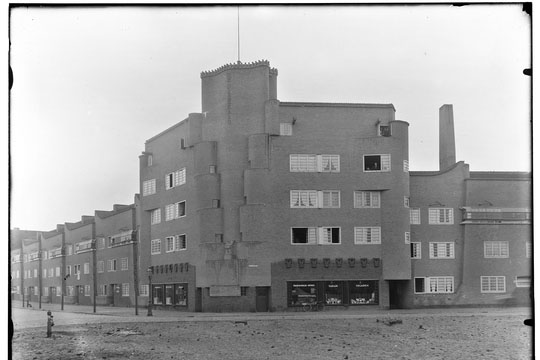The Amsterdam School wasn't a literal school, but rather a movement in art and architecture that emerged in 1916 from a group of friends involved in the Amsterdam architectural society Architectura et Amicitia. Key figures like Michel De Klerk, Piet Kramer, Joan van der Mey, Margaret Staal-Kropholler, Jan Gratama, and Hendrik Wijdeveld were bold innovators with visionary and political ambitions, aiming to revolutionize architecture and urban planning.
Exuberant, dynamic architecture
These Amsterdam School artists sought new forms that suited their vision of society. It was time to break with old forms and seek solutions that were different from Berlage's approach.
Breaking with Berlage
Berlage had done away with traditional, past-inspired design, but his approach was businesslike and austere. The young Amsterdam School architects decorated the streetscape with their exuberant and dynamic architecture. Their buildings are recognizable by their expressive use of color and materials and rich ornamentation.
Form and function
Much of this richness serves the spatial role of architecture. Amsterdam School buildings define and play up their surroundings both outside and inside. At the same time, they often connect to the characteristics of their context, whether that is a grand square, an enclosed residential street or an idyllic outdoor setting.
Michel de Klerk
Michel de Klerk, the architect of Het Schip, was one of the most important members of the Amsterdam School. Michel de Klerk was born on Zwanenburgwal in 1884 into a large, poor Jewish family. His career began when he was discovered at school at age 14 by architect Eduard Cuypers, who recognized his talent for drawing when he saw how well Michel could copy his school teacher.
The birth of the Amsterdam School
As an apprentice draftsman with Cuypers, De Klerk became friends with Piet Kramer and Jo van der Mey. Together they laid the foundation for the Amsterdam School. Once he began working for himself in 1911, De Klerk established his name primarily with a series of housing blocks in Amsterdam, including for the housing associations Eigen Haard and De Dageraad. In addition to inspiring the new movement, there were also opponents of this architectural style; some were baffled and thought someone who handled traditions and old principles in such a way was simply insane. De Klerk's fans, on the other hand, saw him as an elusive genius who led the way in the design of the modern, dynamic and massive city. In the tribute to De Klerk's sudden death, the despair over the loss of this source of inspiration is particularly striking.
An extraordinary post office
De Klerk designed not only the facades of Het Schip and the houses, but also the interior of the post office, right down to details such as the stained glass and the wall clock. It has become a wondrous space; where else does a vaulted, rectangular ceiling hang above an irregular trapezoidal floor plan? The intense colors of purple blue next to lavender blue, which were brought back during the last restoration, are also remarkable. Thanks to this careful approach around the restoration of the post office, De Klerk's only fully preserved interior design can now be admired again in its full glory.
From architectural work to street kiosk
The architects of the Amsterdam School did not just design buildings. They strove to work out an overall vision for the streetscape; much street furniture was designed by architects and designers in the Amsterdam School style.Amsterdam city architect Pieter Lucas Marnette (1888-1948) has much to his credit. His designs include the famous standing giro box, the red fire alarm and the street kiosk. Anton Kurvers (1889-1940) is responsible for the helmet-shaped municipal giro box and architect Jo van der Mey (1878-1949) gave the famous Amsterdam street urinal, the Krul, a new look. The street furniture can be admired in the Museum Garden.
Where it all began
The Housing Act of 1901 was part of a broader wave of legislation around 1900 aimed at improving the living conditions of ordinary citizens. This comprehensive set of measures promoted the clearance of slums and put a stop to the construction of poor-quality, unhealthy housing. One key provision required municipalities to establish building regulations that set clear quality standards for new buildings.
Expansion of Amsterdam
From then on, the design of new city districts had to be laid out in official expansion plans, such as Berlage’s renowned Plan Zuid. Perhaps the most significant outcome of the Housing Act was the rise of so-called “housing act construction”: the development of good, affordable homes by non-profit organizations. The government supported this effort by providing loans to housing associations that built homes for the working class. In its early years, Dutch public housing became a model for Europe, ranking among the best on the continent.
The Spaarndammerbuurt: from poverty to paradise
The Spaarndammerbuurt was developed in the late 19th century to house workers employed in the newly constructed harbor areas nearby. At first, it was a run-down neighborhood, where landlords profited from poorly built, substandard housing. But the introduction of the Housing Act transformed the streetscape: modest yet dignified workers’ homes were constructed, often accompanied by public gardens. The Spaarndammerplantsoen became a green oasis amid the sea of brick. In this area, architect Michel de Klerk designed three remarkable public housing complexes. Breaking away from tradition, he replaced the typical rows of narrow, drab houses with monumental "palaces for the people," using bold forms and expressive brickwork in striking colors.



